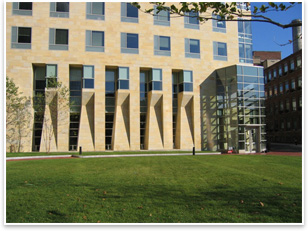| |
 25 Steps to Diversity 25 Steps to Diversity
by Stephen A. Kliment, FAIA
Contributing Editor
Summary: This is the last of 13 episodes in the Diversity Series. The series was designed to serve as an incentive to every design professional, client, educator, and firm principal to act, instead of speaking the comfortable but unproductive phrases that have long typified the dialog and that were smartly demolished last fall by former vice president Al Gore in a speech on his signature topic—the environment:
“Merely engaging in high-minded debates about theoretical future reductions while continuing to steadily increase emissions represents a self-delusional and reckless approach. In some ways, that approach is worse than doing nothing at all, because it lulls the gullible into thinking that something is actually being done, when in fact it is not.” —Al Gore, in a speech at NYU Law School, quoted in The New York Times on September 19, 2006
Gore’s objection to lots of talk but little action in reducing global warming is not unlike the impulse to say the right things about the African-American architect and diversity. Unfortunately, as I wrote in the first episode, this does little to actually advance the cause of black architects. In the Old West they had a pithier phrase: “Talk is cheap but it takes money to buy whiskey.”
So, this final column offers up four critical propositions, followed by a 25-point randomly arranged wrap up of the year’s themes.
 Four Propositions Four Propositions
1. No progress will occur without a strenuous effort by architecture firm partners to hire and mentor black interns and promote worthy middle-level managers
2. No progress will occur unless architecture school deans and senior faculty pull all the levers to identify and attract worthy high school students. Scan the high schools. Stage job fairs to strut your academic wares. Don’t take “We couldn’t find candidates” as an excuse.
3. No progress will occur unless patrons and clients, black as well as white, make a convincing move to give black architects every chance to respond to RFPs and RFQs and apply the same standards of selection as they would to any firm
4. No progress will happen until the major professional journals open up their evaluation criteria to include not only spectacular formal acrobatics by star architects but also well conceived projects that foster the client’s and user’s business operations, thereby opening the doors to all those black architects who, due to their limited access to wealthy adventurous private clients, have hesitated to submit work for publication.
Wrap Up
Market and business development
1. Get into the area of gossip, as the late publisher of Ebony and Jet magazines John P. Johnson advised. They won’t hire you if they don’t know you. Network, mix, promote yourself, speak out, associate. Johnson broke down a longstanding bias against black-owned property in Chicago’s loop by not only setting up his company’s headquarters there but also hiring the black partner in a white firm to be his architect.
2. Use every opportunity to win work. Don’t sneeze at the set-aside and affirmative-action programs (or what remains of them). It’s a simple way to get started and grow. You can always abandon them if the restrictions on size, etc., hold you back.
Education
3. Participation by African Americans in the professional schools has lagged, thanks in part to less than vigorous efforts by the schools to attract students, in part to the reluctance of black teenagers to enter a profession not known for being especially outgoing or remunerative when compared to other professions, plus isolation due to the dearth of black students and faculty at any but the five accredited Historic Black Colleges and Universities (HBCU) architecture schools. Indeed, the number of black students at accredited schools declined between 1991 and 2003, and the number of graduates over that period actually dropped from 214 to 156, or 27 percent. The numbers for faculty aren’t much better: between 1997 and 2003, full-time black faculty declined from 6.2 percent to 5.2 percent. High-profile, articulate black educators such as Sharon Sutton, PhD, FAIA, and Ted Landsmark, PhD, Assoc. AIA, have carried the message to the profession, but much more needs to be done as this is one of the direst chapters in the diversity record. If blacks cannot dramatically raise the volume of black students and graduates, thereby boosting the pool of black graduates from which firms can recruit, white firms will continue to use this excuse for not hiring more black graduates.
 Career planning Career planning
4. Steer clear of role models. It’s a cut-rate way to substitute hero worship for personal initiative and perseverance. Arthur Ashe's widow Jeanne Moutoussamy (daughter of John Johnson’s architect) once said to me that her husband abhorred role models. Simply because you want to emulate Arthur Ashe won't make a star tennis player out of you if you lack the talent and stamina.
Recruitment
5. Majority firm partners: Champion the search for minority interns and hire them. If you don’t set the pace in the firm, who will?
6. Majority firm partners: Once hired, put extra energy into mentoring the new recruit. No one feels comfortable in a group where they are the only one of their race, color, or gender.
7. Mentoring doesn’t mean coddling. The new employee starting to move up the ladder must be held to the same standards as everyone else. Nothing belittles a minority architect in the eyes of colleagues and his or her own eyes than to hold him or her to lower expectations.
Benchmarks
8. Don’t ignore the woeful statistics, but never let them dominate your actions and outlook. The numbers are admittedly painful. Out of more than 101,000 registered architects (all states, no duplication), 1,558, or 1.5 percent are black, according to Dennis Alan Mann’s Center for the Study of Practice at the University of Cincinnati. African Americans make up 12.1 percent of the U.S. population yet supply only 1.5 percent of the nation's architects. This has changed little over the past decade. As a nation, we worship statistics, but there’s more to architectural accomplishment than numbers—there’s quality, reliability, initiative, creativity, perseverance—hard to measure but just as vital in the equation of success.
9. Look at the good news. In recent years, 75 percent of minority firms reported profits of 10 percent or more before taxes, discretionary bonuses, and profit sharing. Those profits were higher than the rate for all firms, black and white.
10. Black firms that cited losses likewise had a better record than all firms, accounting for slightly less than the 13 percent average for all firms.
11. Black women architects have fared better, as have women in general, in playing a larger role. Of the 1,558 black architects listed in 2006 by Dennis Mann, 185 or 11.9 percent are women. This compares to 49 women in Mann’s 1991 database, a whopping 278 percent increase in 15 years.
12. Black firm ownership is high as a percentage of black architects. Said another way, of the 1,558 architects, 608 or 39 percent cite ownership—a high figure, but taken with a grain of salt as ownership ranges from huge firms such as Moody/Nolan to single proprietorships.
13. Six percent, or 1,055, of the AIA’s 17,589 member firms are minority firms. That includes all minorities. The figure has declined from 1,190 cited in 2000.
 African identity African identity
14. Some black U.S. architects still champion a design philosophy that draws on African building, ornament, and art, hoping to create an African style in America. This has always struck me and others as unfounded, unless the building project has a direct cultural link with the African-American community or client, such as a church or community center. I cite Olufemi Majekodunmi, a Nigerian architect and former president of the International Union of Architects (UIA), who reminded a New York audience of mostly black American architects that some of their roots in America go back 300 years, hence their work is or should be shaped by American conditions—program, site, budget.
Racism
15. There’s residual racism on both sides that states that “the white man’s ice is colder.” Many public and private clients and patrons have the flawed belief that majority firms perform better than black firms. Such firms are closely scrutinized and clients expect them to produce a level of work not demanded of majority firms of equal talent.
16. Promotion has been known to be denied to black employees when matched against majority and female colleagues of equal merit. But success has rewarded such architects as Ralph Jackson, FAIA, design partner at Shepley Bulfinch Richardson and Abbott, an establishment Boston Brahmin firm (which also has a woman president); Max Bond, FAIA, name partner at Davis Brody Bond Aedas; and, in a pioneering decision 40 years ago, John Moutoussamy (1920-1995), who became a name partner in Chicago’s Dubin, Dubin and Moutoussamy and designed John Johnson’s Chicago corporate headquarters.
Opportunity to innovate
17. The bread and butter of many black-owned firms, especially those whose workload is a steady diet of run-of-the-mill public work on tight budgets, leaves little opportunity to develop striking new forms and technological breakthroughs.
Getting published
18. The limited amount of black architects’ work to garner design honor awards or to be published in the major professional journals is traceable directly to the scenario of commissions on tight budgets and public clients unwilling to sanction work that stands out and could be deemed extravagant by the taxpayers. It is indeed a vicious circle.
19. Reacting to a pattern of rejections, many black firms hesitate to submit work to the journals, in spite of direct, vigorous, and repeated urging over the years by the chief editors of at least two of the national professional journals.
Caliber
20. Without question, there are black firms in practice today whose work is on a level of design excellence equal to any firm in the nation. But the opportunity to be a Frank Gehry, Rem Koolhaas, Zaha Hadid, or Jean Nouvel still escapes them—although African-born UK architect David Adjaye has in the past year been rapidly gaining star status.
 Success Success
21. Forty years after Whitney Young Jr. admonished the AIA for its laggard attitude to race, Marshall Purnell, FAIA, will serve as the Institute’s president in 2008. In a brief talk with me in spring of 2007, Purnell made it clear he saw himself above all as leader of every architect of whatever ethnic, racial, or gender stripe, and his blackness should not be a matter for special attention—a truly statesmanlike stance.
22. A growing cadre of successful black-owned firms is producing exceptional work. Architects such as Philip Freelon; William Stanley, FAIA; Ivenue Stanley, FAIA; Robert Brown, AIA; Michael Willis, FAIA; Jack Travis, FAIA; Victor Body-Lawson, AIA; Charles McAfee, FAIA, and his daughters Cheryl McAfee-Mitchell, FAIA, and Charl McAfee-Duncan, AIA; Moody/Nolan; Stull & Lee; Roberta Washington, FAIA; A. V. Pope, AIA; Zevilla Jackson Preston; Rodney Leon, AIA; Donald King, FAIA; and R. T. Coles, FAIA, are among firms that have succeeded. Several have been profiled in this diversity series.
Patronage
23. The well-to-do black’s role as patron of black architects continues to be elusive. Except for such individuals as Bill Cosby in show business, Deborah Wright in banking, and the late Atlanta mayor Maynard Jackson in urban politics, the mold has been to select majority architects for major commissions. The reason given is that the advisors surrounding the black celebrity are mostly white, and black architects simply are not within their area of gossip. Another explanation is that a majority architect, especially a star figure with a high profile, is more likely to attract publicity and help in fundraising. No racial or ethnic patron is under any obligation to hire architects only from one of their own, but it is time to be resolute and—other things being equal—hire the black architect.
Alternate careers
24. Corporate architect incumbents include Andrew Thompson, AIA, chief architect at Memorial Sloan-Kettering Cancer Center, and Ricardo Herring, FAIA, a senior official at the National Institutes of Health Office of Research Facilities. Statistics do not break out this specialty, but anecdotal evidence hints at a very low ratio of black architects in these positions of great influence.
25. In the public realm, architects of all colors have advanced in the tradition started by Thomas Jefferson. Richard Swett, FAIA, a majority architect, has served in Congress and as ambassador to Denmark. Among black practitioners, the name of Harvey Gantt, FAIA, stands out as a resourceful former mayor of Charlotte, N.C. In office today are several black architects, among them Toni Griffin, director of community development in Newark, N.J.; William Gilchrist, department head in the administration of the City of Birmingham since 1993; and Mitchell Silver, PP, AICP, department head in Raleigh. These are powerful posts and viable roles for civic-minded black architects.
Conclusion
Alyson M. Cole, political science professor at Queens College, CUNY, in a recent letter to The New York Times, wrote in part: “What black men and women need are jobs, not another pep talk.” I hope this series has eschewed pep talk and instead pointed out accomplishments along with paths to growth.
|
|

 25 Steps to Diversity
25 Steps to Diversity




